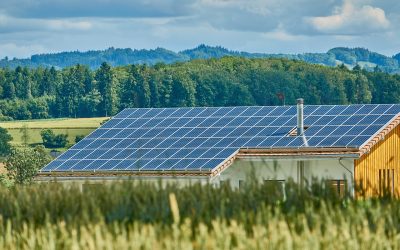So, you’ve heard about the importance of preserving nature, but have you ever wondered specifically why we should focus on conserving wilderness areas? Well, let me break it down for you. Wilderness areas, those untouched and pristine pockets of land, play a vital role in maintaining the balance and biodiversity of our planet. Not only do they provide crucial habitats for countless species, but they also serve as a natural buffer against climate change and a sanctuary for scientific research. By protecting these wilderness areas, we are not only safeguarding our own future but also honoring the incredible beauty and inherent value of the natural world.
Importance of Conservation
Conservation of wilderness areas is crucial for multiple reasons. Firstly, it is essential for preserving biodiversity. Wilderness areas are often home to a wide variety of plant and animal species, some of which may be endangered or have high ecological significance. By protecting these areas, we can ensure the survival of these species and maintain ecological balance.
Secondly, conservation is important for protecting ecosystems. Wilderness areas often contain unique and fragile ecosystems that are highly sensitive to disturbance. By safeguarding these areas, we can prevent habitat destruction and maintain the delicate environmental balances that these ecosystems depend on.
Conservation also plays a vital role in promoting sustainability. Wilderness areas are often rich in natural resources, and their sustainable management is crucial for the long-term well-being of both local communities and the global environment. By implementing sustainable practices and ensuring the responsible use of resources, we can meet the needs of the present without compromising the ability of future generations to meet their own needs.
Lastly, conservation of wilderness areas is crucial for preserving cultural heritage. Many wilderness areas hold great cultural and historical significance, serving as sacred sites or areas of traditional importance for local indigenous communities. By protecting these areas, we can preserve the invaluable cultural heritage and traditional practices that have shaped our world.
Threats to Wilderness Areas
Unfortunately, wilderness areas face numerous threats that put them at risk. Deforestation is one such threat, as it leads to the loss of vital habitat for wildlife and contributes to climate change. Mining and extraction also pose significant threats, as they can cause irreversible damage to ecosystems and result in the pollution of water and soil.
Climate change is another major threat to wilderness areas, as rising temperatures and changing weather patterns can disrupt ecological processes and lead to the loss of biodiversity. Invasive species, introduced by human activities, can outcompete native species and degrade ecosystems. Additionally, urbanization and the expansion of human settlements into wilderness areas can lead to habitat destruction and the fragmentation of natural habitats.
Conservation Strategies
To effectively conserve wilderness areas, various strategies need to be implemented. First and foremost, establishing protected areas is crucial. These designated areas provide legal protection for the preservation of natural habitats and species. By designating wilderness areas as protected areas, we can safeguard them from destructive activities and ensure their long-term preservation.
Biodiversity monitoring is another essential strategy in conservation efforts. Regular monitoring and research can help identify changes in species populations and ecosystems, enabling informed conservation decisions. This knowledge is crucial for assessing the effectiveness of conservation measures and adapting strategies as needed.
The promotion of sustainable tourism is also important in conserving wilderness areas. When done responsibly, tourism can provide economic opportunities to local communities while simultaneously raising awareness about the importance of conservation. Supporting sustainable tourism practices, such as minimizing environmental impact and promoting cultural preservation, can help ensure a harmonious relationship between tourism and conservation.
Engaging local communities in conservation efforts is crucial for long-term success. By involving local people in decision-making processes and providing incentives for conservation, we can foster a sense of ownership and stewardship. This can lead to the sustainable management of resources and the protection of wilderness areas.
Furthermore, international collaboration is essential for effective conservation. Many wilderness areas span multiple countries, making it necessary to work together to develop common goals, share resources, and facilitate the exchange of knowledge and best practices.
Protected Area Management
Once designated, protected areas need to be effectively managed to ensure their conservation objectives are met. Clear regulation and enforcement are crucial to prevent illegal activities, such as logging or poaching, within these areas. Regular monitoring and patrols are necessary to ensure compliance and deter illegal activities.
Ecological restoration is also significant in protected area management. Efforts should be made to restore degraded ecosystems, such as reforestation or habitat restoration. This helps to preserve biodiversity and promote the recovery of natural habitats.
Preventing poaching is another important aspect of protected area management. Poaching, driven by the illegal wildlife trade, poses a severe threat to wildlife populations, particularly for species such as elephants or rhinos. Strict measures, such as increased surveillance and penalties, must be enforced to combat poaching effectively.
Fire management is crucial for maintaining the ecological balance within protected areas. Controlled burning can help prevent the spread of wildfires, reduce the risk of uncontrolled burning, and promote the regeneration of some plant species. However, careful planning and monitoring are required to ensure fires are managed safely and do not negatively impact habitats or wildlife.
Finally, sustainable resource utilization is vital in
protected area management. Responsible and sustainable practices in resource extraction, such as fishing or timber harvesting, ensure that the needs of local communities are met while minimizing the impact on ecosystems. Balancing resource utilization and conservation objectives is crucial for the long-term sustainability of protected areas.
Benefits of Wilderness Conservation
Conservation efforts to protect wilderness areas have far-reaching benefits. One of the key advantages is the improved habitat for wildlife. By preserving wilderness areas, we ensure the existence of suitable habitats for a wide range of species. This allows wildlife populations to thrive and maintain healthy ecosystems.
Conservation also acts as a tool for mitigating climate change. Wilderness areas, with their vast forest cover and intact ecosystems, act as carbon sinks, absorbing and storing large amounts of carbon dioxide from the atmosphere. By safeguarding these areas, we help reduce the concentration of greenhouse gases, mitigating the impacts of climate change.
Furthermore, conservation contributes to enhanced water and air quality. Wilderness areas often serve as natural filtration systems, purifying water by allowing it to pass through undisturbed ecosystems. Similarly, they contribute to cleaner air by absorbing pollutants and releasing oxygen. By protecting wilderness areas, we can ensure the availability of clean water and air for both human and ecosystem health.
Conservation also brings economic benefits through tourism opportunities. Many wilderness areas attract tourists from around the world, drawn by the unique natural beauty and cultural heritage they offer. Tourism can provide employment opportunities for local communities, generate revenue, and foster sustainable economic development.
Lastly, wilderness conservation is essential for the preservation of indigenous cultures. Many wilderness areas are home to indigenous communities whose cultural traditions and practices are deeply intertwined with the natural environment. Protecting these areas helps preserve their traditional knowledge and way of life, contributing to cultural diversity and ensuring the continuation of ancestral heritage.
Challenges to Conservation Efforts
While the importance of conservation is clear, numerous challenges hinder these efforts. Limited funding is a significant obstacle, as conservation often requires significant financial resources for research, monitoring, enforcement, and community engagement. Securing funding for conservation projects can be a constant struggle, particularly in developing countries that face competing priorities.
Political interests can also pose challenges to conservation efforts. Sometimes, short-term political goals and economic interests may overshadow long-term environmental concerns, leading to the exploitation of wilderness areas for resource extraction or unsustainable development. Balancing these interests with the need for conservation is a complex challenge that requires political will and strong governance.
Lack of public awareness and understanding is another obstacle to conservation. Many people may not fully appreciate the importance of wilderness areas and the need to protect them. Building public awareness through education and outreach programs is crucial in fostering a sense of responsibility and support for conservation efforts.
Conflicts with local communities can also pose challenges. In some cases, the establishment of protected areas can disrupt the livelihoods and traditional practices of local communities, leading to resentment and resistance towards conservation efforts. Balancing the needs and rights of local communities with conservation objectives is vital for sustainable and inclusive conservation practices.
Finally, global inequality poses a significant challenge to conservation efforts. Natural resource exploitation and habitat destruction often disproportionately affect developing countries, where poverty and inequality are more prevalent. Addressing these underlying social issues is crucial for creating an enabling environment for conservation.
Examples of Successful Conservation
Despite the challenges, there have been notable successes in wilderness conservation around the world. Yellowstone National Park in the United States stands as one such example. It was the world’s first national park, established in 1872, and serves as a model for protected area management. Yellowstone’s success stems from its stringent regulations, effective enforcement, and collaborative management approach involving government agencies, local communities, and indigenous tribes.
The Galápagos Islands in Ecuador is another success story. These unique islands played a crucial role in shaping Charles Darwin’s theory of evolution and are home to numerous endemic species. Strict regulations, such as visitor quotas and restricted access, along with community involvement, have helped protect the fragile ecosystems and ensure the sustainability of tourism activities.
Serengeti National Park in Tanzania is renowned for its annual migration of wildebeest, zebra, and other grazing animals. Effective management, including anti-poaching measures and community engagement, has helped maintain the wildlife populations and preserve the cultural heritage of the Maasai communities living in and around the park.
The Great Barrier Reef in Australia, the world’s largest coral reef ecosystem, has faced numerous threats, including climate change and pollution. However, through stringent regulations, marine park zoning, and collaborative efforts with scientists, local communities, and the tourism industry, significant progress has been made in protecting and conserving this iconic natural wonder.
The Amazon Rainforest, spanning several South American countries, is a globally recognized example of both the challenges and successes in conservation. Despite ongoing threats from deforestation and illegal activities, efforts by governments, NGOs, and indigenous communities have led to the establishment of protected areas and sustainable management practices, helping to mitigate the impacts and preserve this vital ecosystem.
The Role of Technology
Technology plays a crucial role in enhancing conservation efforts in wilderness areas. Satellite monitoring provides vital data on land cover changes, deforestation hotspots, and encroachment into protected areas. This information enables conservation organizations and governments to identify areas of concern and take appropriate action.
Artificial intelligence is also being increasingly utilized in conservation. Machine learning algorithms can analyze large datasets and identify patterns or anomalies, providing valuable insights into wildlife populations, habitat quality, and threats. Such information helps in making informed decisions and allocating resources effectively.
Remote sensing technology, such as drones or aerial photography, allows for detailed mapping and monitoring of wilderness areas. This helps in identifying habitat changes, monitoring wildlife populations, and assessing the effectiveness of conservation measures.
Geographic Information Systems (GIS) have revolutionized conservation by enabling the integration, analysis, and visualization of spatial data. GIS technology helps in land use planning, identifying critical areas for conservation, and assessing the ecological connectivity between different wilderness areas.
Lastly, big data analysis plays a significant role in conservation by utilizing large datasets from various sources, including citizen science initiatives, to gain insights into biodiversity patterns, track species movements, and assess the impacts of conservation projects. This information is invaluable in guiding conservation actions and measuring their effectiveness.
Public Engagement and Education
Public engagement and education are crucial for building support and awareness for wilderness conservation. Awareness campaigns play a vital role in informing the general public about the importance of wilderness areas and the threats they face. Utilizing various media platforms, such as television, social media, and print, can help reach a wide audience and deliver key conservation messages.
Environmental education programs in schools and universities are essential for equipping future generations with the knowledge and understanding necessary to become responsible stewards of the environment. By incorporating conservation topics into the curriculum and providing hands-on experiential learning opportunities, young people can develop a sense of responsibility and empathy towards nature.
Volunteer programs offer opportunities for individuals to actively contribute to conservation efforts. Whether it is participating in habitat restoration projects, assisting with research and monitoring, or engaging in community outreach activities, volunteers play a crucial role in supporting conservation organizations and initiatives.
Citizen science initiatives have also gained popularity in recent years. These programs allow members of the public to contribute to scientific research by collecting data on wildlife sightings, habitat quality, or invasive species. Through these collaborations, valuable scientific information can be gathered, enhancing our understanding of wilderness areas and supporting conservation efforts.
Partnerships with non-governmental organizations (NGOs) are integral to conservation efforts. NGOs often have extensive expertise in conservation and can provide support through funding, capacity building, and advocacy. Collaborating with NGOs allows for the pooling of resources, knowledge, and networks to ensure more effective and comprehensive conservation initiatives.
Future Directions and Outlook
Looking ahead, several key strategies and areas of focus can shape the future of wilderness conservation. Expanding protected areas and creating new ones is essential to protect more wilderness areas and ensure greater connectivity between existing protected areas. This can provide larger habitats for wildlife, enable the movement of species, and enhance the overall effectiveness of conservation efforts.
The integration of indigenous knowledge and practices is crucial for sustainable and culturally appropriate conservation strategies. Recognizing the invaluable traditional knowledge held by indigenous communities and including them in decision-making processes can lead to more holistic and effective conservation approaches.
Green economy initiatives can also drive conservation efforts. Promoting sustainable industries, such as eco-tourism, renewable energy, and sustainable agriculture, can provide economic opportunities while aligning with conservation principles. Investing in green infrastructure and sustainable development practices can help alleviate poverty and inequality while ensuring the long-term preservation of wilderness areas.
Addressing climate change is paramount for the future of wilderness conservation. Climate change poses significant risks to wilderness areas, including habitat loss, increased frequency of extreme weather events, and changes in species distributions. Combating climate change through greenhouse gas emissions reduction and adaptation strategies is necessary to safeguard wilderness areas and promote their resilience.
Lastly, international cooperation and collaboration are essential for the future of wilderness conservation. Many wilderness areas span multiple countries, and conservation challenges can only be effectively addressed through collective action. Strengthening international frameworks, sharing knowledge and resources, and fostering partnerships between governments, conservation organizations, and local communities are crucial for achieving shared conservation goals.
In conclusion, the conservation of wilderness areas is of utmost importance for the preservation of biodiversity, protection of ecosystems, promotion of sustainability, and preservation of cultural heritage. Despite the threats and challenges, successful conservation efforts, advancements in technology, public engagement, and education provide hope for the future. By adopting effective conservation strategies, enhancing protected area management, and addressing global challenges, we can secure the benefits of wilderness conservation for present and future generations.










